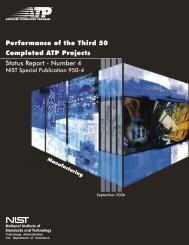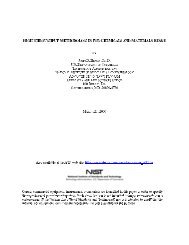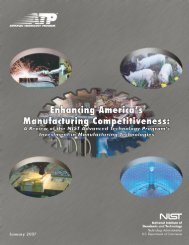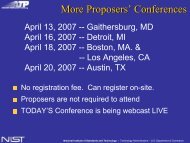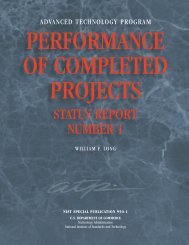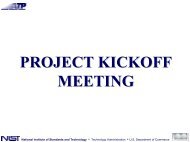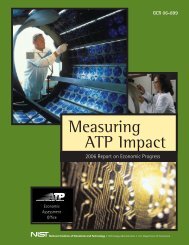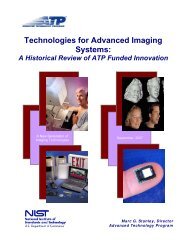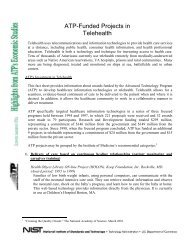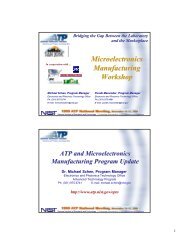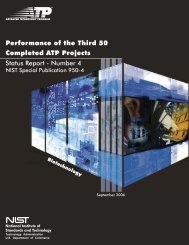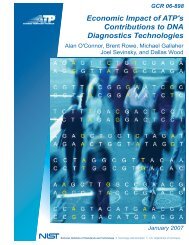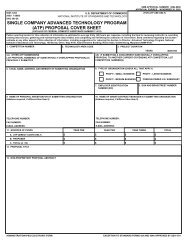Direct and Spillover Effects of ATP-Funded Photonics Technologies
Direct and Spillover Effects of ATP-Funded Photonics Technologies
Direct and Spillover Effects of ATP-Funded Photonics Technologies
- No tags were found...
Create successful ePaper yourself
Turn your PDF publications into a flip-book with our unique Google optimized e-Paper software.
A body <strong>of</strong> research evidence demonstrates that <strong>ATP</strong> projects do indeed generate positivespillovers. However, empirical studies <strong>of</strong> privately funded industrial R&D indicate that R&Din general generates spillovers, whether funded by the government or not. It is insufficient for<strong>ATP</strong> evaluation, then, as Jaffe (1996) points out, “simply to cite the existence <strong>of</strong> spillovers.The <strong>ATP</strong> must be able to show that the government policy portfolio including the <strong>ATP</strong> ismore effective at correcting the R&D market failure problem than the portfolio without the<strong>ATP</strong> would be.” He adds, “If the <strong>ATP</strong> can succeed in targeting projects with better-thanaveragespillover potential, then it will generate large social returns that would not otherwisehave been achieved.”EXPANDING ASSESSMENT METHODOLOGIESFour questions have been central in <strong>ATP</strong> evaluation research:Question 1:Question 2:Question 3:Question 4:Has <strong>ATP</strong> advanced scientific <strong>and</strong> technological knowledge?Has <strong>ATP</strong> increased the economic <strong>and</strong> competitive performance <strong>of</strong>U.S. companies?Has <strong>ATP</strong> generated net benefits that spillover to the broader economy?Does <strong>ATP</strong> succeed in identifying big spillover projects, relative towhat would happen without <strong>ATP</strong>?Existing evaluation methods begin by estimating the direct effects <strong>of</strong> <strong>ATP</strong> on its participants,gathering data through interviews, surveys, document reviews, <strong>and</strong> expert forecasts <strong>and</strong> usingmetrics such as revenues, productivity gains, resource savings, decreased productmaintenance costs, improved product quality, <strong>and</strong> reduced time required to launch newproducts. This value to participants is represented conceptually below as the center circle inFigure 1. Evaluating the incremental effect <strong>of</strong> <strong>ATP</strong> is a counterfactual (or counter-temporal)exercise <strong>of</strong> comparing the current (or estimated future) state to what might have been (orwas before) without <strong>ATP</strong>.Evaluating the impact on nonparticipants is more difficult. Part <strong>of</strong> the methodologicalproblem is that spillover benefits come in two main flavors: a) value or benefits to customers,competitors, <strong>and</strong> suppliers <strong>of</strong> the technology innovator (market spillovers); <strong>and</strong> b) knowledgeto others not in the same markets, perhaps even completely unrelated to the developer(knowledge spillovers). Most <strong>ATP</strong> case studies focus on the value to participants <strong>and</strong> thevalue <strong>of</strong> market spillovers, especially to customers/users. This is shown by the shaded regions<strong>of</strong> Figure 1. The value <strong>of</strong> knowledge spillovers to other players outside the target market (thelower right quadrant in Figure 1) has not been directly or explicitly measured.4 DIRECT AND SPILLOVER EFFECTS OF <strong>ATP</strong>-FUNDED PHOTONICS TECHNOLOGIES



